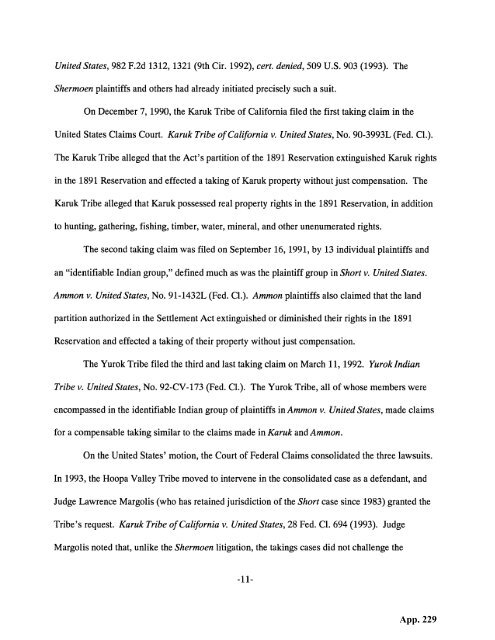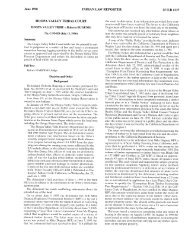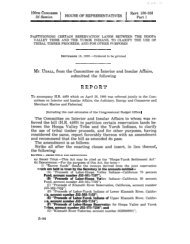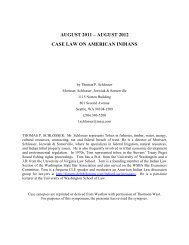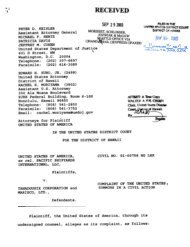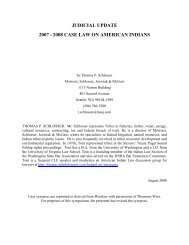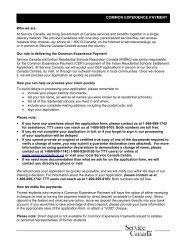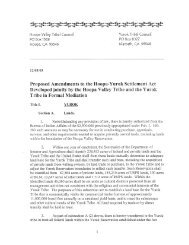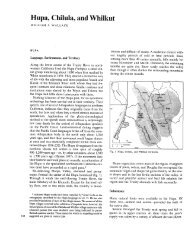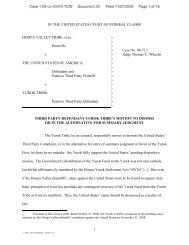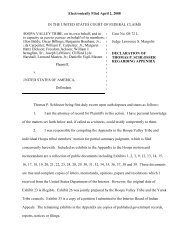Hoopa appendix supporting summary judgment - Schlosser Law Files
Hoopa appendix supporting summary judgment - Schlosser Law Files
Hoopa appendix supporting summary judgment - Schlosser Law Files
You also want an ePaper? Increase the reach of your titles
YUMPU automatically turns print PDFs into web optimized ePapers that Google loves.
United States, 982 F.2d 1312, 1321 (9th Cir. 1992), cert. denied, 509 U.S. 903 (1993). The<br />
Shermoen plaintiffs and others had already initiated precisely such a suit.<br />
On December 7, 1990, the Karuk Tribe of California filed the first taking claim in the<br />
United States Claims Court. Karuk Tribe of California v. United States, No. 90-3993L (Fed. Cl.).<br />
The Karuk Tribe alleged that the Act’s partition of the 1891 Reservation extinguished Karuk rights<br />
in the 1891 Reservation and effected a taking of Karuk property without just compensation. The<br />
Karuk Tribe alleged that Karuk possessed real property rights in the 1891 Reservation, in addition<br />
to hunting, gathering, fishing, timber, water, mineral, and other unenumerated rights.<br />
The second taking claim was filed on September 16, 1991, by 13 individual plaintiffs and<br />
an “identifiable Indian group,” defined much as was the plaintiff group in Short v. United States.<br />
Ammon v. United States, No. 91-1432L (Fed. Cl.). Ammon plaintiffs also claimed that the land<br />
partition authorized in the Settlement Act extinguished or diminished their rights in the 1891<br />
Reservation and effected a taking of their property without just compensation.<br />
The Yurok Tribe filed the third and last taking claim on March 11, 1992. Yurok Indian<br />
Tribe v. United States, No. 92-CV-173 (Fed. Cl.). The Yurok Tribe, all of whose members were<br />
encompassed in the identifiable Indian group ofplaintiffs in Ammon v. United States, made claims<br />
for a compensable taking similar to the claims made in Karuk and Ammon.<br />
On the United States’ motion, the Court of Federal Claims consolidated the three lawsuits.<br />
In 1993, the <strong>Hoopa</strong> Valley Tribe moved to intervene in the consolidated case as a defendant, and<br />
Judge <strong>Law</strong>rence Margolis (who has retained jurisdiction ofthe Short case since 1983) granted the<br />
Tribe’s request. Karuk Tribe ofCalifornia v. United States, 28 Fed. Cl. 694 (1993). Judge<br />
Margolis noted that, unlike the Shermoen litigation, the takings cases did not challenge the<br />
-11-


